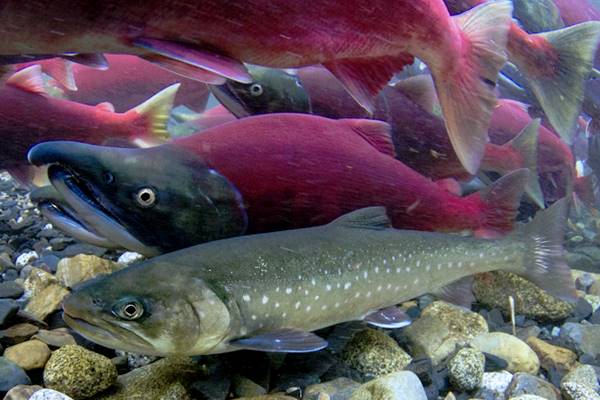Shifting salmon migration proves no obstacle to egg-eating Dolly Varden, study finds
When changing climate drives one species to shift the timing of its entire life cycle, organisms dependent on it must adjust or suffer in its absence. The repercussions of altered salmon migration may be negatively impacting other creatures from bears to aquatic invertebrates, but the char species Dolly Varden seems to be doing just fine amid all the confusion.
Chris Sergeant, an ecologist with the National Park Service, began studying Dolly Varden after moving to Juneau, Alaska, and reading into the local scientific literature. When he came across the annual reports from a nearby weir capture project, he knew he had found “a really incredible data set,” but he didn’t realize it would become the foundation for a study on the uncanny synchronization between migrating salmon and the char that eat their eggs.
“It was a total side project for fun,” Sergeant said. “It had absolutely nothing to do with my job, I’m just a fish geek and I had a bunch of fish geeks with me.”
That side project grew from an object of curiosity into a comprehensive study published online ahead of print in the December 2014 edition of Freshwater Biology.
To learn whether Dolly Varden were adapting to changing salmon migration, Sergeant and his co-authors looked a decade of data from Auke Creek’s weir capture project. Sergeant said the project is one of the longest-running fish surveys in North America.
“This Auke Creek weir has been counting every single fish that moves in and out of that river since 1970,” Sergeant said. “There’s been a lot of great research coming up from it.”
A first look showed that fish were passing through the weir earlier and earlier over a 40-year period. The researchers focused on 10 years of data starting after the weir was modified to collect both salmon and Dolly Varden, and began drawing more detailed connections between the salmon and char.

Char entering tributary stream in Sam Creek, Lake Nerka, Alaska with a wave of sockeye salmon. (Credit: Jonathan B. Armstrong / University of Wyoming)
The researchers broke down the data to see how many salmon and other fish entered the weir in comparison to the number of Dolly Varden entering the weir on the same day. They also ran the capture data — as well as hydrological parameters such as precipitation, streamflow and water temperature — through a model to help determine whether environmental factors or presence of salmon were influencing the char’s presence at the weir.
“It turned out that you could predict Dolly Varden numbers pretty well with the environmental numbers at the weir, but you could do it even better with the salmon,” Sergeant said.
The Dolly Varden appeared to be adjusting their trips to Auke Creek to sync with the salmon. Sergeant said this is significant not only to the char, who might starve through the winter without the nourishment of salmon eggs, but also to Alaska’s angling community.
“Dolly Varden have become a lot more popular in Alaska. There’s a lot more people targeting these fish in sport fisheries,” he said. “If you manage salmon fisheries so that just enough salmon are coming back to spawn, that may not be good enough [to support Dolly Varden recruitment].”
Going forward, Sergeant would like to uncover the mechanisms that set Dolly Varden apart from so many other organisms. Though he has no conclusive findings on that subject, Sergeant has a pretty good hunch: these char move around enough to keep abreast of the comings and goings of salmon.
“I think it’s part of their migratory behavior. They’re really hard to track, they move all over,” Sergeant said. “They probably have the ability to kind of swim by these creek mouths and either see the adult salmon entering or they smell the eggs.” Dollies, he noted, are believed to possess a keen sense of smell.

Char in a stream full of salmon. (Credit: Jonathan B. Armstrong / University of Wyoming)
Many other animals, he said, don’t have the luxury of such mobility. A bear, for instance, can’t wait by its favorite creek for three months, hoping that a salmon might swim by. An Arctic tern can do nothing but hope tasty fish await it when it makes its lengthy migration.
While Sergeant is looking forward to learning more about the sturdy char, he acknowledges that his work wouldn’t be possible without the “extremely rich source of data” made available by projects such as the Auke Creek weir.
“The torch I’ve been carrying this whole time is for long-term monitoring data,” he said. “The government spends a lot of money measuring the same things year after year. It’s teaching people a lot.”
“I can’t stress its importance enough.”

0 comments